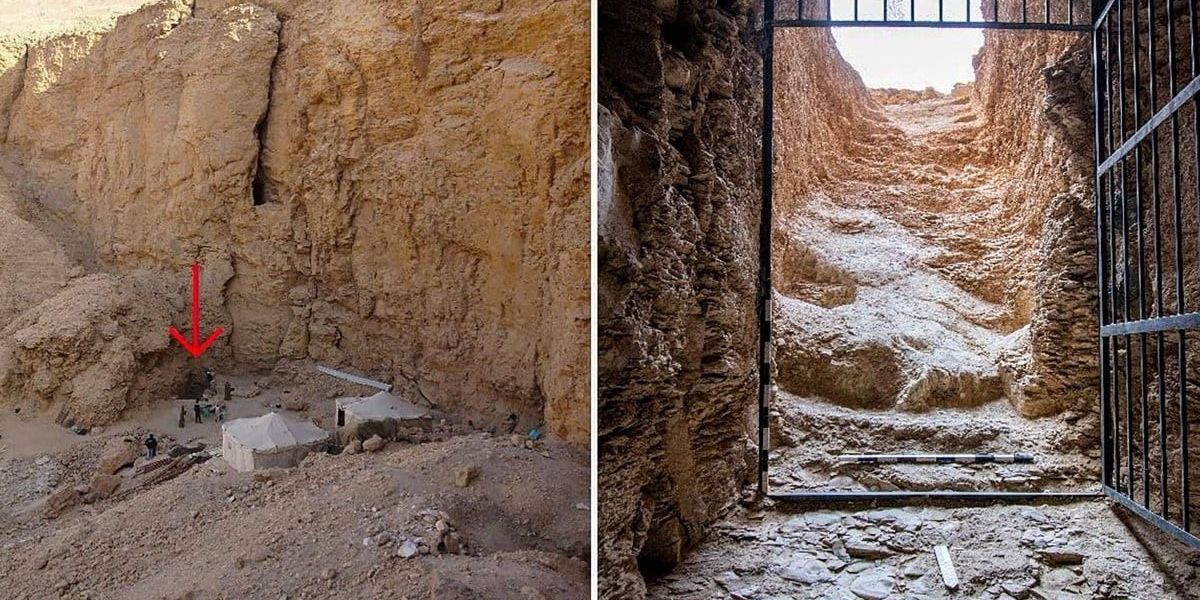British Egyptologists have revealed the crucial clues which led them to the historic discovery of the 3,500-year-old tomb of King Thutmose II.
The site, identified as “Tomb C4”, was located about 1.5 miles west of the Valley of the Kings by a UK-Egyptian team led by Professor Piers Litherland from the University of Cambridge.
The entrance to the tomb and its main passage were initially discovered in 2022 during a joint mission between Litherland’s New Kingdom Research Foundation and the Egyptian Ministry of Tourism and Antiquities.
Prof Litherland, who has explored the Valley of the Kings for more than a decade, discovered a rocky staircase at the bottom of a steep cliff face, which led to a corridor descending further inside the rock.
Prof Litherland discovered a rocky staircase at the bottom of a steep cliff face in the Valley of the Kings – inside was Thutmose II’s tomb
MINISTRY OF ANTIQUITIES
“Initially we thought we might have found the tomb of a royal wife, but the wide staircase and the large doorway suggested something more important,” Prof Litherland told The Times.
The passage was filled with sand and limestone sediment from ancient flooding.
Archaeologists had to crawl through a 10-metre passageway with a small gap to reach the burial chamber.
Inside the chamber, archaeologists found a blue-painted ceiling adorned with yellow stars – a feature exclusive to kings’ tombs, the professor told the BBC.
The burial chamber also contained scenes from the Amduat, a religious text reserved for kings.
MORE ARCHAEOLOGY BREAKTHROUGHS:
The site was located about 1.5 miles west of the Valley of the Kings by this UK-Egyptian team led by Professor Piers Litherland
NEW RESEARCH FOUNDATION
Fragments of alabaster jars bore inscriptions identifying Thutmose II as the “deceased king”, alongside his wife Hatshepsut’s name.
But unlike the grand tomb of Tutankhamun, this chamber contained no mummified body or grave goods.
Experts believe the tomb was strategically emptied years after burial due to flooding, with the treasures potentially still hidden in the area.
“The possible existence of a second, and most likely intact, tomb of Thutmose II is an astonishing possibility,” said Mohsen Kamel, the mission’s assistant field director.
Thutmose II was the fourth Pharaoh of the 18th dynasty of Egypt
WIKIMEDIA COMMONS
Thutmose II was the fourth Pharaoh of the 18th dynasty of Egypt, with historians debating whether his reign lasted 13 years (1493-1479 BC) or just three years (1482-1479 BC).
He died young, described as a “falcon of the nest” when he came to the throne, after fathering Thutmose III.
The 18th dynasty, part of Egypt’s New Kingdom period, ruled for over 200 years until 1292 BC.
The discovery is the first major breakthrough since the 1922 Tutankhamun find by London-born archaeologists Howard Carter and Lord Carnarvon.
Carter’s team found steps leading to a sealed doorway in the Valley of Kings, later uncovering an antechamber filled with thrones and chariots.
When asked by Lord Carnarvon if he could see anything in the burial chamber, Carter famously replied: “Yes – wonderful things!”
